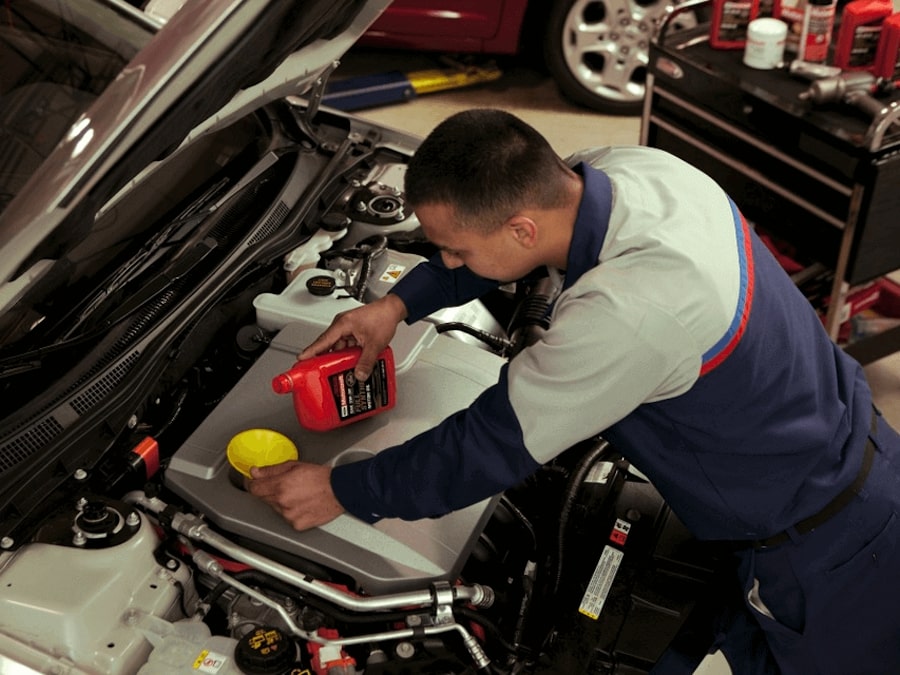Your Ford truck is more than just a vehicle; it’s a workhorse, an adventure companion, and a reliable partner on the road. But to keep your Ford truck running smoothly and reliably for years to come, regular maintenance is non-negotiable. Whether you’re hauling heavy loads or cruising down the highway, neglecting proper Ford truck maintenance can lead to costly repairs, decreased performance, and even safety hazards.
But don’t worry – Ford truck maintenance doesn’t have to be overwhelming. By understanding the basics and establishing a routine maintenance schedule, you can ensure your truck stays in top shape. From simple tasks like checking your oil and tire pressure to more involved procedures like brake inspections, each aspect of Ford truck maintenance plays a crucial role in its overall health.
One of the most effective ways to maintain your Ford truck running like new is to follow a Ford truck maintenance schedule. This schedule outlines the specific maintenance tasks your truck needs at different intervals, based on mileage and driving conditions. By adhering to this schedule, you’ll proactively address potential issues before they become major problems, saving you time, money, and frustration in the long run.
Ford Truck Maintenance Schedule
Why a Ford Truck Maintenance Schedule is Essential
Imagine your Ford truck as a well-oiled machine – each part working in harmony to deliver power, performance, and reliability. A Ford truck maintenance schedule is the blueprint that keeps this machine running smoothly. Think of it as preventative medicine for your truck. Instead of waiting for something to break and then scrambling to fix it (reactive repairs), you proactively address potential issues before they become major problems.

Why is this approach so important?
- Preventative maintenance saves you money. Addressing minor issues early on can prevent them from escalating into costly repairs down the line.
- It maximizes your truck’s lifespan. Regularly maintaining your ford truck helps ensure that all components are in good working order, extending the overall life of your truck.
- It optimizes performance. A well-maintained ford truck performs better, delivering better fuel efficiency, handling, and overall driving experience.
- It ensures safety. Many maintenance tasks directly impact your truck’s safety on the road. For example, regular brake inspections and fluid checks are crucial for maintaining optimal braking performance.
To truly maintain a Ford truck, you need to be proactive rather than reactive.
Understanding Your Ford Truck’s Service Intervals
Your Ford truck’s maintenance needs aren’t one-size-fits-all. Different components require attention at different intervals. These intervals are typically based on mileage and driving conditions. Here’s a breakdown of some common Ford truck maintenance tasks and their typical service intervals:
- Oil Changes: Every 5,000-10,000 miles (depending on oil type and driving conditions)
- Tire Rotation: Every 5,000-8,000 miles
- Brake Inspection: Every 15,000 miles (or more frequently if you notice any issues)
- Transmission Fluid Change: Every 30,000-60,000 miles (refer to your owner’s manual)
- Coolant Flush: Every 30,000-50,000 miles
These are just a few examples, and the specific intervals for your truck may vary. It’s crucial to consult your Ford truck’s owner’s manual for the manufacturer’s recommended Ford truck maintenance schedule and Ford truck service intervals.
How to Create Your Personalized Ford Truck Maintenance Schedule
While your owner’s manual is an excellent starting point, creating a personalized Ford truck maintenance schedule will help you stay on top of your truck’s specific needs. Here’s how to do it:
- Review Your Owner’s Manual: Use the recommended Ford truck maintenance schedule as a baseline.
- Factor in Your Driving Habits: Do you frequently haul heavy loads? Drive in extreme weather conditions? Adjust the frequency of certain maintenance tasks accordingly.
- Consider Your Truck’s Age and Model: Older trucks may require more frequent maintenance than newer models.
- Use Online Resources: Many websites and apps offer tools for creating and tracking your Ford truck maintenance schedule.
- Consult a Ford Mechanic: If you’re unsure about any aspect of your schedule, seek professional advice.
Remember, a well-maintained Ford truck is a happy truck! By taking the time to create and follow a personalized maintenance schedule, you’ll be rewarded with years of reliable performance and enjoyment.
Essential DIY Ford Truck Maintenance Tasks
Maintaining your Ford truck doesn’t always require a trip to the mechanic. By taking a DIY approach to certain tasks, you can save money, learn more about your vehicle, and ensure it stays in top-notch condition.
Here’s an expanded look at some essential maintenance tasks you can handle yourself:
Ford Truck Maintenance Under the Hood
- Checking and Changing Engine Oil: Engine oil is your truck’s lifeblood, lubricating moving parts, reducing friction, and preventing excessive wear. Regular oil changes are crucial for maintaining engine health and longevity.
- DIY Steps: Gather the correct oil and filter, warm up the engine, then safely drain the old oil and replace the filter. Consult your owner’s manual for specific instructions and recommended oil type/viscosity. Remember to properly dispose of the used oil.

- Inspecting Belts and Hoses: Belts and hoses play a vital role in your engine’s cooling and power systems. Regular inspection helps identify cracks, fraying, or leaks before they cause major problems.
- DIY Tips: Check for wear and tear by visually inspecting the belts and hoses. Look for cracks, splits, or softness. Squeeze the hoses to feel for any weak spots. Ensure belts have proper tension.
- Checking and Topping Off Fluids: Your Ford truck relies on various fluids to function correctly. Regularly check the levels of engine coolant, brake fluid, power steering fluid, transmission fluid, and windshield washer fluid.
- DIY Steps: Locate the reservoirs or dipsticks for each fluid, check the levels, and top them off as needed. Use the correct fluids specified in your owner’s manual.
Ford Truck Maintenance: Tires, Brakes, and Suspension
- Checking Tire Pressure and Tread Depth: Properly inflated tires ensure optimal handling, fuel efficiency, and safety. Underinflated tires can cause premature wear and increase the risk of a blowout.
- DIY Steps: Use a tire pressure gauge to check each tire’s pressure when they are cold. Compare the readings to the recommended pressure listed in your owner’s manual or on the tire placard (usually located on the driver’s side door jamb). Use a tread depth gauge to measure the remaining tread.
- Tire Rotation: Regularly rotating your tires promotes even wear and extends their lifespan. It’s generally recommended to rotate your tires every 5,000-8,000 miles.
- DIY Tips: Refer to your owner’s manual for the recommended rotation pattern. While you can rotate tires yourself, balancing is often best left to a professional with specialized equipment.
- Inspecting Brakes for Wear: Brakes are critical for safety. Regularly inspect your brake pads and rotors for signs of wear, such as thinning pads or grooved rotors. If you hear squealing or grinding noises, it’s definitely time for a professional inspection.
- DIY Tip: If you’re mechanically inclined, you can replace brake pads yourself, but it’s a more involved task and requires proper tools and safety precautions.
- Basic Suspension Checks: Your truck’s suspension system is responsible for a comfortable ride and stable handling. Regularly check for leaks in the shocks and struts, as well as any signs of damage or wear on other suspension components.
- DIY Tips: Look for fluid leaks around the shocks and struts. Pay attention to any unusual noises or clunking sounds while driving. If your truck feels excessively bouncy or unstable, have a professional inspect the suspension.
DIY Ford Truck Maintenance: Electrical and Interior
- Checking Battery Health: A healthy battery is essential for starting your truck and powering its electrical systems. Check the terminals for corrosion and clean them with a baking soda and water mixture.
- DIY Tip: If your battery is more than three years old, consider having it tested by a professional to assess its condition and ensure it’s charging properly.
- Inspecting Lights and Signals: Regularly check all your truck’s lights, including headlights, taillights, brake lights, turn signals, and hazard lights. Replace any burned-out bulbs promptly.
- Replacing Cabin Air Filter: The cabin air filter helps remove dust, pollen, and other pollutants from the air inside your truck. A dirty filter can reduce airflow and compromise the efficiency of your HVAC system.
- DIY Steps: Consult your owner’s manual for the location of the cabin air filter (often behind the glove box). Remove the old filter and replace it with a new one.
By tackling these DIY Ford truck maintenance tasks, you’ll gain a deeper understanding of your vehicle, save money on labor costs, and ensure that your truck is always ready for the road ahead.
When to Seek Professional Ford Truck Service
While the DIY spirit is admirable, and many Ford truck maintenance tasks can be handled at home, some situations demand the expertise of a professional mechanic. Knowing when to seek help is crucial for your truck’s well-being and your safety on the road.

Signs Your Ford Truck Needs Professional Attention
- Dashboard Warning Lights: Your truck’s dashboard is equipped with a sophisticated network of sensors and warning lights. These lights are designed to alert you to potential problems that require attention. Ignoring them can lead to further damage and costly repairs.
- Check Engine Light: This light can indicate a wide range of issues, from a loose gas cap to a serious engine malfunction. A mechanic can diagnose the problem using a diagnostic scanner.
- Oil Pressure Warning Light: This light indicates low oil pressure, which can cause severe engine damage if not addressed immediately.
- Brake System Warning Light: This light may come on due to low brake fluid, worn brake pads, or a malfunction in the anti-lock braking system (ABS).
- Battery Light: This light signals a problem with the charging system, such as a faulty alternator or a loose battery connection.
- Temperature Warning Light: This light indicates that your engine is overheating, which can cause significant damage if not addressed quickly.
- Unusual Noises or Smells: Your Ford truck should operate smoothly and quietly. If you notice any unusual noises, such as grinding, squealing, knocking, or clunking, it could be a sign of a problem with your brakes, engine, transmission, or suspension. Similarly, strange smells like burning rubber, sweet coolant, or rotten eggs can indicate underlying issues.
- Grinding or squealing brakes: Worn brake pads or rotors can produce these noises.
- Knocking engine: This could be caused by a variety of problems, such as low oil pressure, worn bearings, or a timing belt issue.
- Burning smell from under the hood: This could indicate a fluid leak or an electrical problem.
- Sweet-smelling exhaust: This is often a sign of a coolant leak.
- Decreased Performance: If your truck isn’t performing as well as it used to, it’s time to consult a mechanic. Decreased performance can manifest in various ways, including:
- Difficulty starting: This could be due to a weak battery, a faulty starter, or a problem with the fuel system.
- Rough idling: A rough idle can be caused by a variety of issues, such as dirty spark plugs, a vacuum leak, or a problem with the fuel injectors.
- Loss of power: If your truck struggles to accelerate or climb hills, it could be a sign of a problem with the engine, transmission, or exhaust system.
- Poor gas mileage: A sudden decrease in fuel efficiency can indicate a problem with the engine, oxygen sensor, or fuel system.
Finding a Reliable Ford Truck Mechanic or Dealership
Choosing the right mechanic or dealership for your Ford truck is a decision that shouldn’t be taken lightly. Here are some key factors to consider when making your choice:
- Certifications and Experience: Look for mechanics who are certified by the National Institute for Automotive Service Excellence (ASE) and have experience working on Ford trucks specifically.
- Reputation and Reviews: Check online reviews on platforms like Google and Yelp to see what other customers have to say about their experiences. Word-of-mouth recommendations from friends and family can also be valuable.
- Warranty Coverage: If your truck is still under warranty, taking it to an authorized Ford dealership will ensure that any repairs are done according to Ford’s specifications and may be covered under your warranty.
- Communication and Transparency: Choose a mechanic who is willing to explain the problem and the recommended repairs in terms you can understand. A transparent pricing structure and upfront estimates are also important.
- Specialized Services: If your truck has specific needs, such as diesel engine repair or performance upgrades, look for a shop that specializes in those areas.

Common Ford Truck Maintenance Mistakes to Avoid
To keep your Ford truck in top shape, be aware of these common maintenance mistakes:
- Ignoring Warning Signs: Don’t ignore dashboard warning lights, unusual noises, or performance issues. Addressing problems early can often prevent them from becoming more serious and expensive.
- Skipping Scheduled Maintenance: Follow the maintenance schedule outlined in your owner’s manual. Skipping oil changes, tire rotations, and other routine tasks can lead to premature wear and costly repairs.
- Using Incorrect Fluids and Parts: Always use the fluids and parts recommended by Ford for your specific truck model. Using the wrong fluids or aftermarket parts can damage your truck and void your warranty.
- Overloading Your Truck: Exceeding your truck’s payload capacity can strain the engine, transmission, brakes, and suspension.
- Neglecting Tire Pressure: Under-inflated or over-inflated tires can lead to poor handling, decreased fuel efficiency, and increased tire wear. Check your tire pressure regularly and adjust it as needed.
By avoiding these common mistakes and seeking professional help when necessary, you can maximize your Ford truck’s lifespan, performance, and safety.
Additional Ford Truck Maintenance Resources
Beyond the basic DIY tasks, there’s a wealth of information and support available to Ford truck owners who want to delve deeper into maintenance and repairs. Here are some valuable resources to explore:
Online Forums and Communities for Ford Truck Owners
The internet is a treasure trove of knowledge when it comes to Ford truck maintenance. Online forums and communities are teeming with passionate Ford truck enthusiasts who are eager to share their experiences, tips, and troubleshooting advice.
Benefits of Connecting with Other Ford Truck Enthusiasts
- Troubleshooting: Get help diagnosing and solving problems you’re experiencing with your truck.
- DIY Guides and Tutorials: Find step-by-step instructions and videos for various maintenance and repair tasks.
- Product Recommendations: Get advice on the best parts, tools, and accessories for your Ford truck.
- Community Support: Connect with other Ford truck owners, share stories, and build lasting friendships.
Popular Ford Truck Forums and Communities
- Ford Truck Enthusiasts (FTE) Forums
- F150 Forum
- Ford-Trucks.com
Ford Truck Maintenance Manuals and Guides
Having access to reliable information is key for successful DIY maintenance. Here’s where you can find official and unofficial Ford truck maintenance resources:
Official Resources
- Owner’s Manual: Your truck’s owner’s manual is the most authoritative source for maintenance schedules, procedures, and specifications.
- Ford Owner website: Ford’s official website offers a wealth of resources for owners, including how-to videos, maintenance guides, and a searchable database of technical service bulletins.
Unofficial Resources
- Haynes Repair Manuals: Haynes manuals provide detailed instructions for various repairs and maintenance tasks, often with helpful illustrations and diagrams.
- Chilton Repair Manuals: Similar to Haynes manuals, Chilton manuals offer comprehensive repair guides for DIY enthusiasts.
- Online Repair Guides: Many websites offer free or subscription-based repair guides for specific Ford truck models.

Ford Truck Maintenance Tools and Supplies
Having the right tools and supplies on hand makes DIY maintenance much easier and more efficient. Here’s a list of essential items for your Ford truck maintenance toolkit:
Basic Tools
- Socket and Wrench Set: For removing and tightening bolts and nuts.
- Screwdrivers: Flat-head and Phillips-head for various tasks.
- Pliers: Needle-nose and slip-joint pliers for gripping and manipulating small parts.
- Torque Wrench: For tightening bolts to the correct specifications.
- Oil Filter Wrench: For removing and installing oil filters.
- Jack and Jack Stands: For safely lifting your truck off the ground.
Essential Supplies
- Engine Oil: Choose the correct type and viscosity for your truck.
- Oil Filter: Replace with every oil change.
- Coolant: Keep a supply on hand for topping off.
- Brake Fluid: Use the type recommended in your owner’s manual.
- Power Steering Fluid: Check and top off as needed.
- Transmission Fluid: Consult your owner’s manual for the correct type and change interval.
- Windshield Washer Fluid: Keep your windshield clean for optimal visibility.
- Shop Towels and Rags: For cleaning up spills and wiping down parts.
- Disposable Gloves: Protect your hands from dirt and grime.
By utilizing these resources and equipping yourself with the right tools and supplies, you’ll be well on your way to becoming a confident and capable DIY Ford truck mechanic. Remember, taking care of your truck is an investment in its longevity, performance, and overall value.
Conclusion
Your Ford truck is a powerful and versatile machine, built to withstand the demands of work and play. By following the Ford truck maintenance tips outlined in this guide, you can ensure that your truck continues to deliver reliable performance, impressive longevity, and optimal safety for years to come.
Remember, Ford truck maintenance isn’t just about fixing problems as they arise – it’s about preventing them in the first place. A well-thought-out Ford truck maintenance schedule, tailored to your truck’s specific needs and your driving habits, is the key to keeping your truck in peak condition. Don’t underestimate the impact of simple tasks like checking fluids, inspecting tires, and adhering to service intervals. These seemingly small steps can make a significant difference in the long run.
Whether you’re a seasoned DIY mechanic or prefer to leave the major repairs to the professionals, understanding the importance of Ford truck maintenance is essential for every truck owner. By investing a little time and effort into regular maintenance, you’ll be rewarded with a truck that not only runs smoothly but also retains its value over time.
Do you have any Ford truck maintenance tips or tricks that you’d like to share? We’d love to hear from you! Leave a comment below and let us know your favorite maintenance hacks. And if you found this guide helpful, be sure to subscribe to our blog for more informative automotive content. Together, we can keep our Ford trucks running strong!